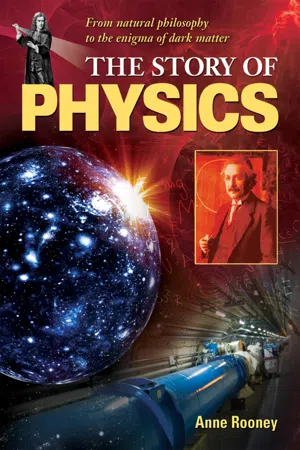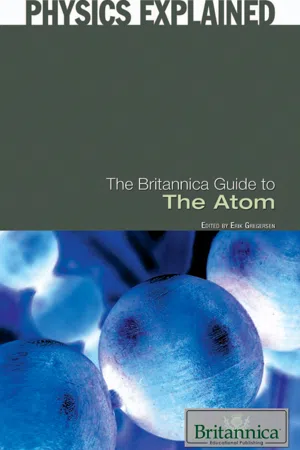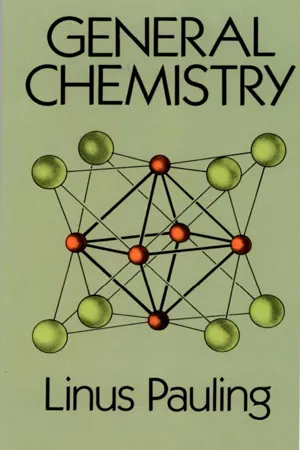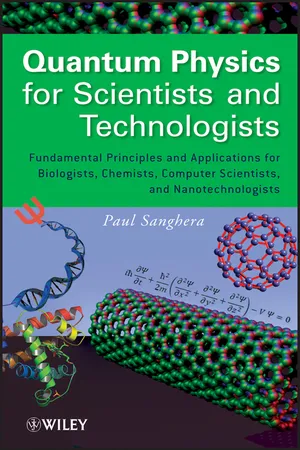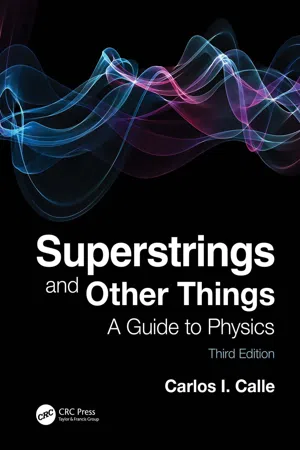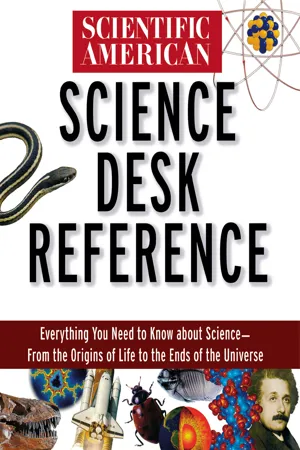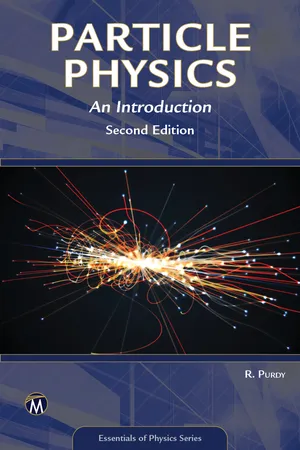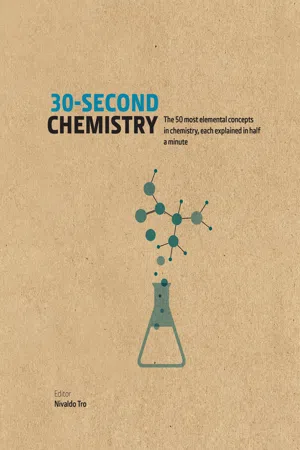Physics
The Discovery of the Atom
The discovery of the atom is a significant milestone in the history of science, marking the understanding of the fundamental building blocks of matter. It involved the contributions of various scientists, including John Dalton, J.J. Thomson, Ernest Rutherford, and Niels Bohr, who conducted experiments and proposed models to describe the structure and behavior of atoms, leading to the development of modern atomic theory.
Written by Perlego with AI-assistance
Related key terms
Related key terms
1 of 4
Related key terms
1 of 3
11 Key excerpts on "The Discovery of the Atom"
- eBook - ePub
- Anne Rooney(Author)
- 2014(Publication Date)
- Arcturus(Publisher)
CHAPTER 5 Into the ATOM The Discovery of the Atomic structure of matter opened the door to a whole new world for physicists A belief in atoms as the building blocks of matter has an ancient history. Some Buddhist thinkers in the 7th century BC believed all matter to be made of atoms, which they regarded as a form of energy. In Europe, preatomists such as Empedocles and Anaxagoras had also conceived of invisibly tiny particles of matter. These early philosopher-scientists arrived at their view through a process of deductive thought alone. Although atomism fell out of favour for many centuries it was, in the end, the model that would prevail, supported by experimentation and observation. But the early atomists weren’t quite right. Their belief that atoms are the smallest, indivisible particles of matter proved to be incorrect, for atoms are made up of subatomic particles. As scientists probed inside the atom, it would prove to be a bizarre and unpredictable place. Dissecting the atom John Dalton described his atomic theory in 1803, saying that elements are made of identical atoms that combine in ratios of whole numbers to form chemical compounds. The theory was not universally accepted until the French physicist Jean Perrin (1870–1942) measured the size of a water molecule more than a century later, in 1908, though many scientists did accept and work with the theory before this date. But even before the theory had been confirmed as fact, the premise that atoms cannot be subdivided was breaking down. The British physicist Joseph John (J.J.) Thomson (1856–1940) discovered the electron in 1897 during his work on cathode rays and Crookes tubes (see here). Thomson found that cathode rays travel much more slowly than light and so cannot, as previously suspected, be part of the electromagnetic spectrum. He concluded that a cathode ray is actually a stream of electrons - eBook - ePub
- Britannica Educational Publishing, Erik Gregersen(Authors)
- 2010(Publication Date)
- Britannica Educational Publishing(Publisher)
CHAPTER 1 THE ATOM : DEVELOPMENT OF ATOMIC THEORYT he concept of the atom that Western scientists accepted in broad outline from the 1600s until about 1900 originated with Greek philosophers in the 5th century BCE . Their speculation about a hard, indivisible fundamental particle of nature was replaced slowly by a scientific theory supported by experiment and mathematical deduction. It was 2,000 years before modern physicists realized that the atom is indeed divisible and that it is not hard, solid, or immutable.WHAT IS AN ATOM?
The atom is the smallest unit into which matter can be divided without the release of electrically charged particles. It also is the smallest unit of matter that has the characteristic properties of a chemical element. As such, the atom is the basic building block of chemistry.Most of the atom is empty space. The rest consists of a positively charged nucleus of protons and neutrons surrounded by a cloud of negatively charged electrons. The nucleus is small and dense compared with the electrons, which are the lightest charged particles in nature. Electrons are attracted to any positive charge by their electric force. In an atom, electric forces bind the electrons to the nucleus.Because of the nature of quantum mechanics, no single image has been entirely satisfactory at visualizing the atom’s various characteristics, which thus forces physicists to use complementary pictures of the atom to explain different properties. In some respects, the electrons in an atom behave like particles orbiting the nucleus. In others, the electrons behave like waves frozen in position around the nucleus. Such wave patterns, called orbitals, describe the distribution of individual electrons. The behaviour of an atom is strongly influenced by these orbital properties, and its chemical properties are determined by orbital groupings known as shells. What follows in this chapter is a historical survey of the most influential concepts about the atom that have been formulated through the centuries. - eBook - ePub
From Atoms to Higgs Bosons
Voyages in Quasi-Spacetime
- Chary Rangacharyulu, Christopher J. A. Polachic, Chary Rangacharyulu, Christopher J. A. Polachic(Authors)
- 2019(Publication Date)
- Jenny Stanford Publishing(Publisher)
As discussed in the first chapter of this book, the Greek atomists are now remembered as the originators of this atomic theory, and Democritus is renowned as the chief expositor. A few characteristics of his atoms may be reviewed:- Atoms are indivisible4 and stable.
- Atoms are not all identical, but may exist with tremendous diversity.
- Atoms of the same type, or species, are identical in all their properties.
- Atoms may have finite sizes and shapes, and even internal properties.
The essential characteristic of the classical atomic particle is its indivisibility, which suggests an associated stability as one of the properties of these building blocks. It is an unfortunate consequence of history that the word atom now refers, in English, to a unit of a chemical element, understood to be a composite body of smaller entities that has no essential permanence, being susceptible to ionization, radioactive decay, and nuclear fission. But neither the modern redefinition of the word, nor the antiquity of Democritus’ original idea, should be allowed to deprive us of the importance of the atomic concept. With a little care, we can still use the term in its original and literal sense to denote whatever fundamental building blocks of matter our physical investigations finally uncover.The ideas of Democritus and the other ancient atomists were, remarkably, put on firm ground thanks to the experimental science of men such as Robert Boyle, Antoine Lavoisier, and John Dalton in the seventeenth through nineteenth centuries. Dalton, the English chemist, was fully cognizant of the ancient atomic hypothesis and applied it with scientific rigor, investigating the atoms’ relative weights as the principle characteristic accessible to measurement. Already in 1808, Dalton identified 20 “simple” atoms as “ultimate particles,” beginning with hydrogen and ending with the heaviest known to him, mercury. These were understood to combine with other ultimate particles, both of their own and different species, to form more complex molecules.5 - eBook - ePub
- Linus Pauling(Author)
- 2014(Publication Date)
- Dover Publications(Publisher)
The first meaning of the word is that described above-namely, a hypothesis that has been verified. The second use of the word theory is to represent a systematic body of knowledge, compounded of facts, laws, theories in the limited sense described above, deductive arguments, and so on. Thus by the atomic theory we mean not only the idea that substances are composed of atoms, but also all the facts about substances that can be explained and interpreted in terms of atoms and the arguments that have been developed to explain the properties of substances in terms of their atomic structure. 2-2. The Atomic Theory In 1805 the English chemist and physicist John Dalton (1766-1844) stated the hypothesis that all substances consist of small particles of matter, of several different kinds, corresponding to the different elements. He called these particles atoms, from the Greek word atomos, meaning indivisible. This hypothesis gave a simple explanation or picture of previously observed but unsatisfactorily explained relations among the weights of substances taking part in chemical reactions with one another. As it was verified by further work in chemistry and physics, Dalton’s atomic hypothesis became the atomic theory. The rapid progress of our science during the current century is well illustrated by the increase in our knowledge about atoms. In a popular textbook of chemistry written in the early years of the twentieth century atoms were defined as the “imaginary units of which bodies are aggregates.” The article on “Atom” in the 11th edition of the Encyclopaedia Britannica, published in 1910, ends with the words “The atomic theory has been of priceless value to chemists, but it has more than once happened in the history of science that a hypothesis, after having been useful in the discovery and the coordination of knowledge, has been abandoned and replaced by one more in harmony with later discoveries - eBook - ePub
Quantum Physics for Scientists and Technologists
Fundamental Principles and Applications for Biologists, Chemists, Computer Scientists, and Nanotechnologists
- Paul Sanghera(Author)
- 2011(Publication Date)
- Wiley-Interscience(Publisher)
Ancient Greek philosophers, as early as 400 BC, proposed that all matter was composed of some fundamental constituents, which they called atoms. Based on these ideas, an English chemist John Dalton presented his atomic theory of the chemical elements in 1808. The suggestions that atoms themselves were not fundamental (indivisible) came as early as 1820 from experiments revealing that atoms consist of smaller particles: the subatomic particles. By the late nineteenth century, scientists had discovered that all matter was made of (chemical) elements, which in turn were composed of atoms, and atoms might have structure too. But at that time they did not know much about the atom itself, such as its internal structure and dynamics. The study of the structure of an atom has been crucial for the development of chemistry because atomic structure plays a significant role in determining the properties of the chemical elements. Later, the subatomic particles that compose atoms were discovered to be electrons, protons, and neutrons. Various experiments also revealed the structure of the atom: An atom is a stable self-contained entity comprised of protons and neutrons in its nucleus, which is surrounded by a cloud of electrons that exactly match the number of protons in the nucleus.Whereas classical physics failed to explain experimental observations, quantum theory, which was in its infancy at the time, thrived on these experiments by successfully explaining their findings. So, the three underlying streams of thought in this chapter are the atomic theory of elements, the classical theory of atomic structure, and the quantum theory of atomic structure.Note : By now, the scientists know that protons and neutrons that make up the nucleus of an atom also have structures, and they are made up of even smaller particles called quarks. This level of the study of matter is important for the advancement of physics.4.2 QUANTUM MECHANICS OF AN ATOM: THE BIG PICTUREA physicist’s probe of matter goes as deep as possible in the search for the fundamental constituents of matter: from the universe to an atom, to protons and neutrons, to quarks, and beyond. A biologist is interested in studing living matter to the details of a molecular level because that is where life begins its activities in terms of molecules of life, such as deoxyribonucleic acid (DNA), proteins, carbohydrates, and lipids. A chemist is interested in studying matter at the molecular and atomic levels.All matter is made up of a finite number of elements. Each element consists of unique atoms that are different from any other element. These unique atoms exhibit (or reveal) their structure in the spectrum of light (electromagnetic, EM, radiation) that they emit and absorb. You learned about black-body radiation in Chapter 2. In addition to measuring the spectra of black-body radiation, experimental physicists at that time were also familiar with the spectra emitted by gases. Toward the end of the nineteenth century, it was discovered that when an atomic gas was heated by passing an electric current through it, it emited a spectrum of radiation corresponding to only certain specific wavelengths. Such a spectrum is called a line spectrum. Figure 4.1 presents such spectra for a few elements: hydrogen (H2 ), helium (He ), mercury (Hg ), and neon (Ne - eBook - ePub
Reductionism
A Beginner's Guide
- Alastair I. M. Rae(Author)
- 2013(Publication Date)
- Oneworld Publications(Publisher)
2 The building blocks of matterThe word ‘atom’ comes from the ancient Greeks. The idea probably originated with Leukippos, who was born in Miletus in the first half of the fifth century BCE . It was developed and enhanced by Democritus, one of his pupils, who lived in Thrace from 460 BCE to 370 BCE . These thinkers proposed that if a piece of matter is divided into smaller and smaller pieces, a point is eventually reached where further subdivision is impossible. They called this irreducible minimum átomos, which means ‘uncuttable’ or indivisible and then went on to consider how the properties of these atoms might account for the behaviour of matter. They suggested that a substance like iron is solid and hard because the iron atoms possess hooks which connect them together, while the atoms of liquids, such as water, must be smooth and slippery. Although these ideas have considerable resonance with the modern picture of atoms, this is really only a happenstance: the Greeks had no direct evidence for the existence of atoms or any way of estimating their size or mass. Nevertheless, many of the elements of reductionism are present in their thinking, including the idea that large-scale properties emerge from those of an underlying substructure.Although the atomic hypothesis attracted interest from later thinkers, including Isaac Newton, the concept was not significantly developed until the early nineteenth century, when John Dalton proposed his atomic theory. Dalton came from a Quaker family, which at that time meant that he was banned from attending any English university. Instead, he obtained a position in New College in Manchester, which had been founded to provide educational opportunities for those who were not members of the Church of England. Dalton suffered from colour blindness, and one of his earliest scientific papers proposed a theory to account for this condition but today he is remembered chiefly for his atomic theory, which demonstrated how the existence of atoms can account for many of the properties of physical substances. - eBook - ePub
Superstrings and Other Things
A Guide to Physics
- Carlos I. Calle(Author)
- 2020(Publication Date)
- CRC Press(Publisher)
The Greek philosopher Leucippus (believed to have been born in Miletus about 490 BC) is sometimes credited as the originator of the atomic principle. However, it is his student Democritus, a Greek natural philosopher, who was responsible for its introduction into Greek thought.Democritus said that matter was made up of small, indivisible particles, which he called atoms , from the Greek word for indivisible. As the scientific method (as we understand it today) did not exist in the time of Democritus, it did not occur to anyone to check ideas against the experiment. People simply chose among these different ideas on the basis of taste and personal preference. And the views of Democritus were not widely accepted by most philosophers of his time.The atomic concept lay dormant until the nineteenth century, when it was revived by the work of the English scientist John Dalton. Dalton proposed an atomic theory in which he stated that matter is composed of atoms, which he considered to be indivisible particles; that the atoms of a given element are identical; and that atoms are arranged, in chemical reactions, to form molecules.By this time physicists had some understanding of electricity and had identified what the American physicist and statesman Benjamin Franklin called positive charge and negative charge . Experiments had shown that two positive charges repel each other; two negative charges also repel each other; but a positive charge and a negative charge attract each other (Figure 7.1 ). By studying how electrical currents decompose water and other chemical compounds, the English physicist Michael Faraday realized that electricity exists in discrete units or particles. In 1891, these particles of electricity were named electrons .FIGURE 7.1 Like charges (all positive or all negative) repel each other, whereas unlike charges (a positive and a negative) attract each other.These two discoveries would eventually help explain a seemingly unrelated phenomenon that had baffled scientists for years. During the last decade of the nineteenth century, physicists tried to understand the nature of the strange and fascinating glow that appeared when an electric current passed through a wire inside a glass tube from which air had been evacuated. Two metal disks, or electrodes , sealed into the ends of a long glass tube, were connected to a high-voltage battery (Figure 7.2 ). When the battery was connected, a green glow became visible in the glass. Sometimes, investigators would place fluorescent materials inside the tube, which would also glow when the electrical current was present. Since the rays seemed to emanate from the electrode connected to the negative end of the battery which was called the cathode , these rays were known as cathode rays and the evacuated glass tube as a cathode ray tube . These tubes were the forerunners of today’s television picture tubes. The modern computer monitor is still called a CRT - eBook - ePub
- Martin V. Melosi(Author)
- 2016(Publication Date)
- Routledge(Publisher)
48With a chemist colleague, Rutherford also made a major advance with the study of radioactive decay in 1902, nine years before proposing the nuclear atom. They concluded that the disintegration of atoms produced radioactivity. This suggested that radioactivity was not a permanent phenomenon, but actually decreases over time, and that a radioactive substance transforms (or transmutes) into another substance.49 While this was a major claim, designing atomic models that would explain radioactivity in a mechanical way proved confounding.50 Rutherford and others had taken giant leaps in describing the structure of the atom during the first decade of the twentieth century, but atomic physics was now up against a very sturdy wall.THE QUANTUM AND THE EINSTEINIAN WORLD
The inner structure of the atom was now a principle focus of physics, but the old mechanistic theory of the universe seemed wanting for understanding subatomic phenomena. Physicists and chemists struggled with the swirl of ideas and speculations about the nature of the atom. They also struggled with Newton’s mechanical basis of physics versus Maxwell’s electromagnetic one. In the background a new way of understanding that world was emerging. The “quantum,” the smallest unit of energy, signaled a paradigm shift in physics by helping to reveal the subatomic world. In December 1900, German physicist Max Karl Ernst Planck (1858–1947) experimented in the area of thermal radiation, especially the interaction between radiation and matter. In a paper he read before the Physical Society of Berlin, Planck proposed that energy is emitted in small, indivisible amounts which he called “quanta.” The classical view was that energy exchanges only took place in continuous amounts. Planck, a professor of physics at the University of Berlin and a specialist in thermodynamics, hoped that his work would lead to practical applications in the German heating and lighting industries. A long-time opponent of atomic theory, he believed that if atoms existed, they were not mechanical. Neither he nor his contemporaries at first believed that the idea of quanta required serious attention at least on a theoretical level. For five years few scientists discussed the quantum hypothesis.51 - eBook - ePub
- (Author)
- 2008(Publication Date)
- Trade Paper Press(Publisher)
P HYSICS Physics is the branch of science concerned with the laws that govern the structure of the universe, and the properties of matter and energy and their interactions. For convenience, physics is often divided into branches such as atomic physics, nuclear physics, particle physics, solid-state physics, molecular physics, electricity and magnetism, optics, acoustics, heat, thermodynamics, quantum theory, and relativity. Before the 20th century, physics was known as natural philosophy. the atom An atom is the smallest unit of matter that can take part in a chemical reaction, and which cannot be broken down chemically into anything simpler. An atom is made up of protons and neutrons in a central nucleus surrounded by electrons. The atoms of the various elements differ in atomic number, atomic weight, and chemical behavior. Thomson on the Number of Corpuscles in an Atom http://dbhs.wvusd.k12.ca.us/Chem-History/Thomson-1906/Thomson-1906.html J. J. Thomson’s paper on the number of particles, or as he called them corpuscles, in an atom. The Web site is a reproduction of Thomson’s publication in Philosophical Magazine vol 11, in June 1906. nucleus The core of the atom is the nucleus, a dense body only one ten-thousandth the diameter of the atom itself. The simplest nucleus, that of hydrogen, comprises a single stable positively charged particle, the proton. Nuclei of other elements contain more protons, and additional particles called neutrons, of about the same mass as the proton but with no electrical charge. Each element has its own characteristic nucleus with a unique number of protons—the atomic number. The number of neutrons may vary. Atoms of a single element with different numbers of neutrons are called isotopes - eBook - ePub
Particle Physics
An Introduction
- Robert Purdy(Author)
- 2022(Publication Date)
- Mercury Learning and Information(Publisher)
Today, advances in microscopy and nano-technology have moved us into an astonishing world in which physicists and materials scientists can not only see but even manipulate individual atoms. It is sometimes easy to forget that the majority of particle physics has taken place in relatively recent history. Indeed, the very existence of atoms was placed beyond a reasonable doubt only after Einstein’s 1905 paper. Our understanding of the nature of matter has made remarkable progress in a little over 100 years. So by 1905, you may be forgiven for thinking that the continuous/discrete dichotomy had been resolved. The matter was composed of atoms, and the light was composed of waves. Not so fast, though. In the same year that he conclusively demonstrated the discrete nature of matter, Einstein also cast doubt on the wave nature of light, which will be discussed shortly.1.2. ATOMIC STRUCTUREEven before they had been definitively shown to exist, atoms were believed to have structure. A look at the periodic table shows that atoms appear to be built out of the smallest of their kind—the hydrogen atom—since many mass numbers are approximately integer multiples of the mass of hydrogen. This suggested that hydrogen was the fundamental unit of matter and that heavier elements were somehow built out of hydrogen. Those masses with non-integer multiples of the hydrogen mass would later be explained with the discovery of the neutron. Since each element generally comes in several isotopes (forms with equal numbers of protons but differing numbers of neutrons), but a sample typically does not distinguish these isotopes, the measured atomic mass of an element is the mean of the different isotopes weighted by their relative abundance.The next big milestone in particle physics was the discovery of the electron in 1896, by J. J. Thomson. The rays produced by a high-voltage cathode in a near vacuum were believed by some to be a stream of negatively charged molecules, while others believed they were some different kind of particle. The name “electron” had already been given to these hypothetical particles before Thomson demonstrated their existence. By passing cathode rays through electric and magnetic fields and carefully varying the strength of these fields, Thomson was able to perform accurate measurements of the charge-to-mass ratio of the particles in the ray. Assuming the charge to be the same as in previous charge-to-mass ratio measurements of ions gives a mass for the electron of 0.0005 atomic mass units (0.51 MeV), over a thousand times lighter than the hydrogen atom. This lent support to the idea that even the hydrogen atom was not fundamental, but was instead constructed from smaller constituents. In particular, Thomson proposed a model of the atom in which the negatively charged electrons were free to move around in a diffuse cloud of positive charge. This model came to be known as the plum-pudding model and is familiar to most students mainly because of how it was overturned. - eBook - ePub
30-Second Chemistry
The 50 most elemental concepts in chemistry, each explained in half a minute.
- Nivaldo Tro(Author)
- 2020(Publication Date)
- Ivy Press(Publisher)
nuclear model A model for the atom in which most of the mass of the atom is contained in a small dense nucleus composed of protons and neutrons. Most of the volume of the atom is occupied by the electron cloud.nucleosynthesis The process by which elements form within stars.proton A subatomic particle with a positive charge and a mass of 1 amu.quantum mechanics The realm of physics, developed in the early twentieth century, that deals with the very smallest particles that exist.Schrödinger’s Cat thought experiment A thought experiment involving the application of the uncertainty principle to a cat in a box with a radioactive substance that has a 50 per cent chance of decaying. If the atom decays, then the cat dies, so the cat is in a strange state of being both dead and undead, with a 50 per cent probability of each. Schrödinger used this experiment to show that quantum mechanical ideas are not applicable to large scale objects (such as cats).valence electrons The highest energy electrons (and therefore the most important in bonding) in an atom.velocity A measure of how fast (and in what direction) an object is moving.MATTER IS MADE OF PARTICLES
the 30-second chemistryThe Ancient Greek philosophers believed that matter was infinitely divisible – that matter had no fundamental particles. Subsequent thinkers followed suit for more than 2,000 years. It was not until the eighteenth and nineteenth centuries that early chemists used careful measurements – primarily the relative weights of related samples of matter – to determine otherwise. And it wasn’t until the early twentieth century that the question was definitely settled: the 1926 Nobel Prize for Physics was awarded to Jean Perrin for settling the matter. The Greeks were wrong – matter is particulate (it is made up of particles), and those particles are called atoms. And that turns out to be among the most important ideas in all of human thought. Why? Because the idea that matter is made of particles has enabled us to understand nature from the bottom up. What we found was remarkable: as far as we can tell, the particles that compose matter – their composition and structure – determine the properties of matter. Matter does what the particles that compose it do. Water boils at 100°C (212°F) because the three atoms that compose a water molecule bond together in a certain order, at a certain angle and at certain distances. Change any of these characteristics and water would be a different substance.
Index pages curate the most relevant extracts from our library of academic textbooks. They’ve been created using an in-house natural language model (NLM), each adding context and meaning to key research topics.
Explore more topic indexes
Explore more topic indexes
1 of 6
Explore more topic indexes
1 of 4
